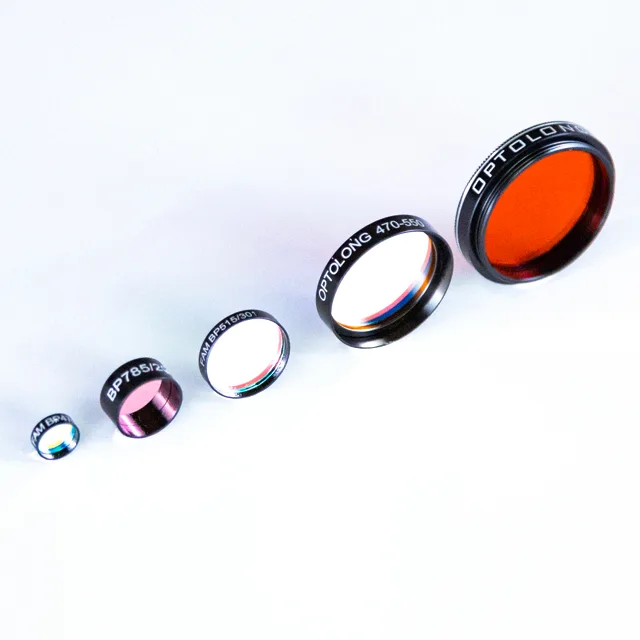With its unique spectral characteristics, the Texas Red filter can effectively improve the contrast of fluorescence imaging, making the observation of cell structures and biomarkers clearer and more precise.
The Texas Red filter significantly improves the visibility of fluorescent markers by selectively transmitting light of specific wavelengths, which is of great help in studying complex biological processes and pathological changes.
Next, we will explore in detail the definition of the Texas Red filter and how it can improve fluorescence imaging technology and image quality.
Understanding fluorescence imaging

Fluorescence imaging relies on the emission of light by substances that absorb light or other electromagnetic radiation. A fluorophore is a fluorescent compound that absorbs photons of a specific wavelength and then re-emits at a longer wavelength.
This process allows researchers to observe and track biomolecules. Fluorescence imaging is widely used in various fields. In biological research, scientists use fluorescence imaging to study cellular processes, protein interactions, and gene expression. Medical diagnostics also benefit from fluorescence imaging because it can detect disease markers and monitor the effectiveness of treatments.
The role of optical filters in fluorescence imaging
In fluorescence imaging, optical filters are used to enhance the quality and contrast of images by precisely selecting specific wavelengths of light. In fluorescence microscopy, the role of filters can be summarized as follows:
- Excitation filter: The excitation wavelength must match the wavelength of the light source to excite the fluorophore.
- Emission filter: The wavelength of the emission filter hits the fluorescent dye.
- Dichroic mirrors: These dichroic mirrors reflect excitation light while transmitting emitted fluorescence.
Choosing the right optical filters can better obtain high-quality fluorescence images. The right filters can isolate the desired fluorescent signal from background noise, thereby enhancing contrast.
Selecting the right filters improves the signal-to-noise ratio, resulting in clearer, more detailed images. Researchers must consider the spectral properties of fluorophores and filters to optimize imaging results.
What is a texas red filter?

A Texas Red filter is a fluorescent dye filter that is specifically designed to absorb and emit specific wavelengths of light, thereby improving contrast and clarity in fluorescence microscopy imaging.
This filter can effectively screen out background light and non-specific fluorescence, allowing only the fluorescence of the Texas Red dye to pass through. The Texas Red dye itself is a red fluorescent dye that is commonly used in biomedical research to label proteins, nucleic acids, and other biomolecules.
For information about Texas Red Filter, please read this article: What is Texas Red Filter?
How texas red filters work
Texas Red filters work by selectively absorbing shorter wavelengths. When light passes through the filter, only the longer wavelengths in the red range are transmitted. This selective transmission enhances the visibility of samples labeled with Texas Red dye. The filter is designed to ensure that unwanted wavelengths are blocked, thus improving image clarity.
Texas Red filters offer distinct advantages over other optical filters. High-performance alternatives such as Alexa Fluor 594 offer similar advantages but with greater solubility and photostability. However, Texas Red filters remain popular because of their specific spectral properties.
How does the texas red filter specifically enhance image contrast?
The specific mechanism by which the Texas Red filter enhances the contrast of fluorescence microscopy images can be understood from the following aspects:
Precise wavelength selectivity
The Texas Red filter is designed to pass a specific range of light wavelengths, usually wavelengths that match the excitation and emission spectra of the Texas Red dye.
This precise wavelength selectivity allows the filter to pass only light that can excite the dye (usually in the red part of the spectrum) while ensuring that the dye’s emission light (longer wavelength red light) can be captured by the detector.
Background light suppression
In fluorescence microscopy imaging, background light (including autofluorescence and scattered light) is one of the main factors affecting image quality. The Texas Red filter can effectively block these non-specific lights from passing through and only allow the specific emission light of the dye to pass through, thereby significantly reducing background noise and improving imaging contrast.
Image clarity and detail enhancement
By suppressing non-specific wavelengths of light, the Texas Red filter helps enhance the details and clarity of imaging. This allows researchers to see cell structures, tissue samples, or labeled molecules more clearly, especially in complex biological samples.
Improve the signal-to-noise ratio of fluorescent signals
The signal-to-noise ratio is an important indicator for evaluating imaging quality. The Texas Red filter improves the signal-to-noise ratio by reducing background light and ensuring that only light from the target fluorescent dye is captured.
A high signal-to-noise ratio means that the fluorescent signal clearly stands out from the background, further improving the contrast.
Suitable for multi-label imaging
In multi-color fluorescent labeling applications, the Texas Red filter can be combined with other filters, each filter allowing only the light of its corresponding fluorescent dye to pass through. This method can observe multiple different biomarkers at the same time, each marker is displayed with high contrast without interfering with each other.
Through these mechanisms, the use of Texas Red filters in fluorescence microscopy significantly improves the quality of images, making scientific research and medical diagnosis more accurate and efficient.
Benefits of using texas red filters

The use of Texas Red filters in fluorescence microscopy offers several benefits that make this filter particularly important in scientific research and clinical applications:
Enhanced contrast
Texas Red filters significantly improve the signal-to-noise ratio of fluorescence imaging. By isolating specific wavelengths, these filters ensure that only the desired fluorescence signal reaches the detector.
This selective transmission minimizes background noise and improves image clarity. Researchers can expect more accurate and reliable results with higher signal-to-noise ratios.
Specificity and sensitivity
Texas Red filters are highly specific in fluorescence detection. The filter is designed to target the red region of the spectrum, which corresponds to the emission wavelength of the Texas Red dye. This targeted approach ensures that only fluorescence from labeled molecules is detected. High specificity allows for accurate identification and localization of specific proteins or cellular structures.
Texas Red filters effectively reduce background noise in fluorescence imaging. By blocking unwanted wavelengths, these filters prevent nonspecific fluorescence from interfering with the signal. Reduced background noise results in clearer, more detailed images. Researchers can obtain high-quality data with minimal interference, improving the overall reliability of their experiments.
Better penetration
The greater penetration of red and near-infrared light makes Texas Red filters particularly suitable for imaging deep tissues. This is extremely valuable in neuroscience, cancer research, and other fields that require deep imaging because it allows researchers to observe deeper biological structures without invasive procedures.
Compatibility and multi-label imaging
Texas Red filters are compatible with other fluorescent dyes and filter systems, supporting multi-label imaging techniques.
This compatibility allows the use of multiple fluorescent dyes to label different molecules or cellular structures at the same time, allowing complex biological processes and interactions to be simultaneously observed and analyzed in the same imaging session.
Improved fluorescence stability
The Texas Red dye itself has high photostability, which means it is less likely to fade during long exposures or multiple imaging sessions. This is an important advantage in studies that require long experiments or repeated imaging.
Therefore, Texas Red filters play a key role in improving the quality of fluorescence microscopy, expanding experimental capabilities, and optimizing imaging conditions. These benefits make Texas Red one of the indispensable tools in many life sciences and medical fields.
Summary
Texas Red filters can effectively enhance fluorescence imaging. These filters isolate specific wavelengths, improving image clarity and contrast. Researchers and clinicians benefit from improved signal-to-noise ratios and reduced background noise. Enhanced imaging results lead to more accurate and reliable data.
Texas Red filters have promoted the in-depth development of biological research and medical diagnosis. Adopting Texas Red filters can significantly improve your imaging results. Consider incorporating these filters into your fluorescence microscopy workflow for better results.
If you want to buy Texas Red filters or other related optical filters, please visit Optolong‘s official website. We offer a variety of filters, including bandpass filters, dichroic mirrors, and some microscope filter cubes. Please contact us for relevant information and quotes!
